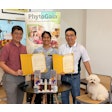
Raw meat-based pet foods continue to gain popularity among pet owners, but also present challenges to reduce the potential for microbial contamination since the products are by definition raw. Without high temperatures to kill pathogens, such as H1N1 avian influenza, Salmonella, Escherichia coli and Listeria monocytogenes, raw pet foods need another means of inactivating potential threats to both pet and human health. Research published in the Journal of Food Protection explored how the combined use of high-pressure processing (HPP) and lactic acid fermentate (LAF), a carbohydrate fermentation product containing lactic acid, may mitigate these health risks from raw dog and cat foods.
High-Pressure Processing as a Pathogen Control Tool
HPP can achieve pathogen reduction in food products, including raw pet food. Previous research by the same team of scientists had already demonstrated that HPP effectively achieves a dramatic reduction of Salmonella spp., E. coli STEC and L. monocytogenes.
“Ingredients used in the different formulations can impact the effectiveness of HPP to deliver a 5-log reduction of pathogens and frozen storage can maintain the log reduction attained by HPP,” the scientists wrote in the Journal of Food Protection “However, E. coli STEC and L. monocytogenes were more HPP resistant than Salmonella spp. and their inactivation by HPP, especially in chicken formulation, can be inconsistent.”
Likewise, challenges remained in preventing the potential regrowth of L. monocytogenes during refrigerated storage.
To address these concerns in their study, the researchers inoculated chicken-based raw pet food with pathogen cocktails and treated the raw pet food with HPP at 586 MPa for durations of 2, 3 and 4 minutes. The effectiveness of HPP was enhanced through the addition of LAF applied at concentrations of 0.7% or 1.0% w/v. The products were stored frozen and monitored over a 21-day period.
Synergistic Effect of Lactic Acid Fermentate
The integration of LAF into the raw pet food formulation significantly improved pathogen inactivation. The study found that:
- Complete Pathogen Reduction: LAF at 1.0% combined with HPP resulted in complete inactivation of Salmonella spp., E. coli STEC and L. monocytogenes.
- Enhanced L. monocytogenes Control: Without LAF, a 4.02-log reduction was observed for L. monocytogenes with a 2-minute HPP hold time, which improved to 4.37-log with a 4-minute hold. Incorporating LAF eliminated the pathogen more effectively.
- Resilience of E. coli STEC: While E. coli STEC exhibited higher resistance to HPP compared to L. monocytogenes, the combination of HPP and 1.0% LAF achieved robust reductions.
Lactic acid disrupts bacterial cells. In acidic environments, undissociated lactic acid crosses bacterial membranes and dissociates within the cytoplasm, leading to acidification, impaired enzymatic functions and eventual cell death. Combined with HPP, which compromises membrane integrity, the synergistic effect results in unrepairable damage to microbial cells.
Operational Implications for the Pet Food Industry
This research highlights the practical applications of combining HPP and LAF for raw pet food manufacturers:
- Formulation and Process Control: The inclusion of LAF provides an additional safety barrier, reducing the reliance on prolonged HPP treatment and minimizing quality degradation.
- Shelf-Life Management: Products treated with HPP and LAF maintained microbial safety during frozen storage, supporting current best practices of frozen distribution and storage.
- Regulatory Compliance: The findings support the use of LAF as a preventive control measure within HACCP and food safety plans to meet stringent pathogen reduction targets.
The integration of lactic acid fermentate with high-pressure processing may offer a scientifically validated method to enhance the microbiological safety of raw pet foods. As consumer demand for raw diets grows, these findings suggest a means for manufacturers to ensure safety without compromising product quality.

















